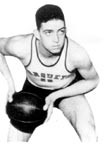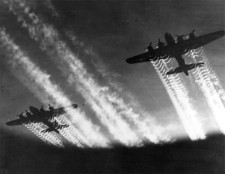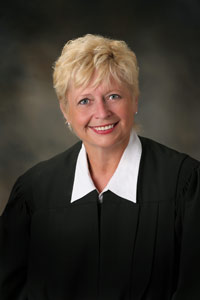 Marquette’s men’s basketball program has produced a long line of All-American basketball players. The ranks of this elite group include such notable hoopsters as George Thompson, Maurice Lucas, Dwayne Wade, Jim Chones, Dean Meminger, Earl Tatum, and Butch Lee.
Marquette’s men’s basketball program has produced a long line of All-American basketball players. The ranks of this elite group include such notable hoopsters as George Thompson, Maurice Lucas, Dwayne Wade, Jim Chones, Dean Meminger, Earl Tatum, and Butch Lee.
However, the first Marquette basketball All-American was 6’2” guard Edward “Boops” Mullen who played for the Hilltoppers (as the team was then known) from 1931 to 1934. Mullen was named as a first team selection to the Converse All-American team following the conclusion of his final varsity season, during which he had been enrolled as a first year Marquette law student.
Mullen was also the first (and to date only) Marquette law student to have played in the NBA or one of its predecessor leagues after receiving his law degree.
Mullen, born in 1913 in Fon du Lac, Wisconsin, enrolled in Marquette as a college freshman in the fall of 1930. The 6’2” Mullen starred on the freshman team and joined the varsity as a starter during the 1931-32 academic year.
Mullen played guard in an era where the players who filed that position were in the lineup primarily to “guard” their team’s basket and to prevent the other team’s top offensive players from scoring.
At Marquette, “Boops” became renowned as a defensive specialist in an era of college basketball in which scores were much lower than they are today. During Mullen’s first year on the varsity, the average combined score in Marquette games was only 57 points, and in only one of the team’s 19 games did either Marquette or its opponent exceed 50 points (and then only scored 51).
Mullen was certainly no offensive standout. For his Marquette varsity career he averaged only 3 points per game, but it was on the defensive side of the game that he excelled. He always guarded the opposing team’s top scorer, and he usually held that player to well below his average number of points.
During Mullen’s first varsity season (1931-32), the Marquette Hilltoppers compiled a record of 11-8, under the leadership of captain and Marquette law student (and future National Basketball League head coach) Frank Zummach. The next year, the team added sophomore scoring sensation, Ray Morstadt, the first Marquette player to average in double figures in scoring for an entire season, and its record improved to 14 wins and 3 losses.
In the fall of 1933, following his junior year of college, Mullen enrolled in the law school as a law freshman. At that time, prospective law students at Marquette were required to have attended college for just two years, and it was not at all uncommon for students in the college who were interested in careers in law to switch to the law school after their sophomore years.
In fact, Mullen was somewhat unusual in waiting until after his junior year of college to start law school. His undergraduate classmate and fellow native of the Fox Valley, future United States Senator Joe McCarthy, followed the more common path of enrolling in the law school after his second year at Marquette.
Mullen’s decision may have the better one, as the law school shortly thereafter (in 1934) raised the entry prerequisite to three years of college.
Enrolling in law school in no way adversely affected Mullen’s play during his final year as a college basketball player. Named captain of the team by head coach Bill Chandler, Mullen and Morstadt led Marquette to its highest win total in more than a decade as the 1933-34 team won 15 games while losing only four. Included in the wins were victories over Big 10 teams Wisconsin, Michigan State, and Ohio State and a season ending 21-20 nail biter against Notre Dame.
At the end of the season, Mullen was named to the Converse Yearbook’s First Team All-American team because of his stellar defensive play, while his teammate Ray Morstadt was named to the Literary Digest’s All American Third Team.
During his second and third year of law school, Mullen was no long eligible to play varsity basketball—in that era, players were limited to one year on the freshman team and three years on the varsity, no matter what their status at their universities. So instead of playing, Mullen coached the Marquette freshman basketball team and assisted Chandler and new assistant coach Frank Zummach with the varsity.
During his second year as a coach and his third year of law school (1935-36), Mullen also began his professional basketball career by signing a contract with the Oshkosh All-Stars.
The All-Stars had been founded in 1929 by an Oshkosh seed distributor and salesman named Lon Darlling. Until 1935, the team had played as an independent professional team (in an era when such teams were common, especially in the Midwest), but that year the All-Stars joined the Midwest Basketball Conference, a league that stretched from Minnesota to Pennsylvania and which was recognized as one of the top professional leagues in the United States.
Presumably, the decision to sign Mullen was part of an effort to upgrade the caliber of the team in the face of more challenging competition.
Mullen became the All-Stars captain and a fixture in the team’s starting line-up. Conference games were irregularly scheduled and accounted for only a small percentage of the games that the team actually played. Playing games throughout Wisconsin and the Midwest and often scheduling games with non-Wisconsin teams in different cities in the Fox Valley and central Wisconsin, the All-Stars compiled a combined record of 54 wins and only 12 losses during the 1935-36 and 1936-37 seasons.
After graduating from the law school in June of 1936 (and securing admission to the Wisconsin bar under the diploma privilege which had been extended to Marquette graduates in 1934), Mullen moved to Oshkosh to play basketball and practice law. He soon entered in a law partnership with Charles A. Bernard, a former member of the Wisconsin legislature and a 1930 graduate of the Marquette Law School. He did not, however, plan to abandon his basketball career.
In 1937, the Midwest Conference changed its name to the National Basketball League as part an effort to upgrade its quality of play and to establish itself as the premier professional basketball league in the United States. In this it largely succeeded, and in 1949, it would merge with the more recently established Basketball Association of America to form the modern National Basketball Association.
In its initial form, the11-team NBL was still centered in the Midwest with teams located in large and medium sized cities (Pittsburgh, Indianapolis, Columbus, and Dayton) as well as in smaller communities like Oshkosh where basketball was extremely popular. (However, some of the small town teams were located on the periphery of major metropolitan areas, like Whiting, Indiana (Chicago) and Warren, Ohio (Cleveland).)
Many of the league’s franchises had begun as industry-sponsored teams, and several retained their original industrial sponsors, like the Ft. Wayne General Electrics and the two Akron teams, the Goodyear Wingfoots and the Firestone Non-Skids. Although the All-Stars were privately owned, the team was, like the Green Bay Packers of the National Football League, a community operation.
The All-Stars proved to be one of the rechristened league’s better teams. In 1937-38, Oshkosh recorded a league record of 12 wins and 2 losses, and an overall record of 62-12. (Higher salaries apparently dictated a significant larger number of games.) The team won the NBL’s Western Division title by a half game over the Whiting (Ind.) Ciesar All-Americans, and in the post-season playoffs, the All-Stars eliminated Whiting, two games to none, before losing the league title to the Akron Goodyear Wingfoots, two games to one.
Balancing a new law practice with such a heavy playing schedule was obviously a challenge for Mullen, but it appears that he did play in a significant number of the team’s games. He remained the team captain, and he managed to play in 9 of the team’s 14 regular season NBL games and in all 5 of its playoff tilts. As at Marquette, Mullen continued to specialize in playing shutdown defense, and his offensive contributions were minimal. In the 14 NBL regular season and playoff games in which he participated, he scored a total of only 24 points.
In the fall of 1938, Mullen married his Marquette girlfriend, Evangeline Gahn, Arts ’34, in Milwaukee, but the two began house-keeping in Oshkosh. The headline over the story in the Oshkosh newspaper announcing the couple’s engagement referred to Mullen as a “local lawyer” rather than as a professional basketball player (although the latter role was mentioned in the text of the story.)
During the 1938-39 season, the All-Stars again won the league’s Western Division championship, this time with a record of 17-11. Unfortunately, they also again lost the league championship to an Eastern Division team from Akron, this time the Firestone Non-Skids. In that year’s one-round of play-offs the All-Stars again fell just short, losing to the Non-Skids by a margin of three games to two.
In spite of a honeymoon that required him to miss some of the team’s early season non-league games, Mullen managed to play in 25 of the 28 regular season games, and actually boosted his scoring average in those games to 2.3 points per contest. In the play-offs, he again played in all five games, but managed only three free throws and no baskets in the entire series.
By the fall of 1939, the demands of his law practice and marriage were making it harder for Mullen to continue his basketball career. Moreover, as scores in professional basketball games began to rise, it may also have been the case that a 6’2” pure defensive specialist was not viewed as quite as valuable as before. In any event, Mullen began the 1939-40 season with the All-Stars but retired after playing in only seven league games.
Without Mullen, the All-Stars finished the season tied for first place in the Western Division with the Sheboygen Redskins, coached by Mullen’s former Marquette basketball teammate, fellow assistant coach, and fellow Marquette law student, Frank Zummach. In the first round of the play-offs Oshkosh defeated Sheboygan two games to one, but then lost in the finals for the second year in a row to Akron’s Firestone Non-Skids, again by three games to two, but this time after blowing a two games to none lead.
Mullen apparently planned to stay in Oshkosh to practice law, but with the outbreak of World War II, he entered the United States Navy, where he held the rank of Lt. j.g. After the war, instead of returning to Oshkosh, he relocated to Milwaukee where he practiced law and coached the Milwaukee Bright Spots, the city’s leading independent professional team.
When the National Basketball Association was created by merger of the NBL and the Basketball Association of America in 1949, there was much speculation that Mullen would return to the All-Stars as an assistant coach, but that issue was muted when the other NBA teams voted to drop Oshkosh from the list of teams in the new league.
Mullen also became increasingly involved in Marquette athletics after his return to Milwaukee. He became an active member of the M Club, an organization of former Marquette athletes created by the university to “provide support for Marquette athletics and to encourage camaraderie among its alumni letter winners.”
In 1950, Marquette president, Edward J. O’Donnell, S.J., appointed Mullen as the M Club representative on the Marquette Athletic Board, and from 1958 to 1960, Mullen served two one-year terms as the M Club’s president.
At some point, Mullen’s first marriage ended in divorce, and he later remarried. His second wife was Goldye Brossell, a native of Milwaukee and a graduate of the city’s now defunct Downer College. Mullen and his second wife moved to Washington, D.C., in 1964, apparently as a result of his taking a job with the Veterans Administration. While in D.C., the new Mrs. Mullen worked as a staff assistant in the social office of First Lady Lady Bird Johnson.
In 1968, the Mullens relocated to San Francisco where he continued to work for the Veterans Administration, and she became the food editor for the San Francisco Progress, a weekly newspaper. In 1979, she published a cookbook, The International Dessert Cookbook, which was widely reviewed.
In 1974, while living in San Francisco, Mullen was elected to Marquette Athletic Hall of Fame, and that same year, he was also selected by a unanimous vote as a member of Marquette’s all-time basketball team.
Mullen died on January 10, 1988, in San Francisco, where he is buried. Both of his wives lived into their mid-90. Evangeline Grah Mullen passed away in 2008, and Goldye Brossell Mullen died in 2009.
 As I have described elsewhere on this blog, Marquette Law School Dean Francis X. Swietlik played a prominent role in public affairs during the Second World War, primarily because of his leadership role in the American Polish Community. As the leader of the “Chicago Poles,” as Midwesterners of Polish descent were known, Swietlik advised President Franklin Roosevelt on Polish issues and was a national spokesman for the cause of his ancestral country — Swietlik had been born in Milwaukee in 1899 — which had been dismembered in 1939 by Nazi Germany and the Soviet Union.
As I have described elsewhere on this blog, Marquette Law School Dean Francis X. Swietlik played a prominent role in public affairs during the Second World War, primarily because of his leadership role in the American Polish Community. As the leader of the “Chicago Poles,” as Midwesterners of Polish descent were known, Swietlik advised President Franklin Roosevelt on Polish issues and was a national spokesman for the cause of his ancestral country — Swietlik had been born in Milwaukee in 1899 — which had been dismembered in 1939 by Nazi Germany and the Soviet Union.

